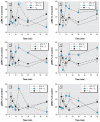Combinations of physiologic estrogens with xenoestrogens alter ERK phosphorylation profiles in rat pituitary cells
- PMID: 20870566
- PMCID: PMC3018487
- DOI: 10.1289/ehp.1002512
Combinations of physiologic estrogens with xenoestrogens alter ERK phosphorylation profiles in rat pituitary cells
Abstract
Background: Estrogens are potent nongenomic phospho-activators of extracellular-signal-regulated kinases (ERKs). A major concern about the toxicity of xenoestrogens (XEs) is potential alteration of responses to physiologic estrogens when XEs are present simultaneously.
Objectives: We examined estrogen-induced ERK activation, comparing the abilities of structurally related XEs (alkylphenols and bisphenol A) to alter ERK responses induced by physiologic concentrations (1 nM) of estradiol (E2), estrone (E1), and estriol (E3).
Methods: We quantified hormone/mimetic-induced ERK phosphorylations in the GH3/B6/F10 rat pituitary cell line using a plate immunoassay, comparing effects with those on cell proliferation and by estrogen receptor subtype-selective ligands.
Results: Alone, these structurally related XEs activate ERKs in an oscillating temporal pattern similar (but not identical) to that with physiologic estrogens. The potency of all estrogens was similar (active between femtomolar and nanomolar concentrations). XEs potently disrupted physiologic estrogen signaling at low, environmentally relevant concentrations. Generally, XEs potentiated (at the lowest, subpicomolar concentrations) and attenuated (at the highest, picomolar to 100 nM concentrations) the actions of the physiologic estrogens. Some XEs showed pronounced nonmonotonic responses/inhibitions. The phosphorylated ERK and proliferative responses to receptor-selective ligands were only partially correlated.
Conclusions: XEs are both imperfect potent estrogens and endocrine disruptors; the more efficacious an XE, the more it disrupts actions of physiologic estrogens. This ability to disrupt physiologic estrogen signaling suggests that XEs may disturb normal functioning at life stages where actions of particular estrogens are important (e.g., development, reproductive cycling, pregnancy, menopause).
Figures

 , ✫). #p < 0.05 compared with cells treated with 1 nM E2, E1, or E3 alone.
, ✫). #p < 0.05 compared with cells treated with 1 nM E2, E1, or E3 alone.
 ). #p < 0.05 compared with cells treated with 1 nM E2, E1, or E3 alone.
). #p < 0.05 compared with cells treated with 1 nM E2, E1, or E3 alone.
 , ✫). #p < 0.05 compared with cells treated with 1 nM E2, E1, or E3 alone.
, ✫). #p < 0.05 compared with cells treated with 1 nM E2, E1, or E3 alone.



Comment in
-
Estrogens from the outside in: alkylphenols, BPA disrupt ERK signaling in vitro.Environ Health Perspect. 2011 Jan;119(1):A34. doi: 10.1289/ehp.119-a34b. Environ Health Perspect. 2011. PMID: 21196144 Free PMC article. No abstract available.
Similar articles
-
Endocrine disruption via estrogen receptors that participate in nongenomic signaling pathways.J Steroid Biochem Mol Biol. 2011 Oct;127(1-2):44-50. doi: 10.1016/j.jsbmb.2011.01.015. Epub 2011 Feb 12. J Steroid Biochem Mol Biol. 2011. PMID: 21300151 Free PMC article. Review.
-
Mixtures of xenoestrogens disrupt estradiol-induced non-genomic signaling and downstream functions in pituitary cells.Environ Health. 2013 Mar 26;12:26. doi: 10.1186/1476-069X-12-26. Environ Health. 2013. PMID: 23530988 Free PMC article.
-
Combinations of physiologic estrogens with xenoestrogens alter calcium and kinase responses, prolactin release, and membrane estrogen receptor trafficking in rat pituitary cells.Environ Health. 2010 Oct 15;9:61. doi: 10.1186/1476-069X-9-61. Environ Health. 2010. PMID: 20950447 Free PMC article.
-
Xenoestrogens at picomolar to nanomolar concentrations trigger membrane estrogen receptor-alpha-mediated Ca2+ fluxes and prolactin release in GH3/B6 pituitary tumor cells.Environ Health Perspect. 2005 Apr;113(4):431-9. doi: 10.1289/ehp.7505. Environ Health Perspect. 2005. PMID: 15811834 Free PMC article.
-
The Influence of Environmental Exposure to Xenoestrogens on the Risk of Cancer Development.Int J Mol Sci. 2024 Nov 18;25(22):12363. doi: 10.3390/ijms252212363. Int J Mol Sci. 2024. PMID: 39596429 Free PMC article. Review.
Cited by
-
Suppression of lymphoma growth by the xenoestrogens bisphenol A and genistein.Endocr Connect. 2018 Dec;7(12):1472-1479. doi: 10.1530/EC-18-0459. Endocr Connect. 2018. PMID: 30496125 Free PMC article.
-
Assessing the carcinogenic potential of low-dose exposures to chemical mixtures in the environment: the challenge ahead.Carcinogenesis. 2015 Jun;36 Suppl 1(Suppl 1):S254-96. doi: 10.1093/carcin/bgv039. Carcinogenesis. 2015. PMID: 26106142 Free PMC article. Review.
-
Neurological Effects of Bisphenol A and its Analogues.Int J Med Sci. 2015 Oct 30;12(12):926-36. doi: 10.7150/ijms.13267. eCollection 2015. Int J Med Sci. 2015. PMID: 26664253 Free PMC article. Review.
-
Endocrine-disrupting chemicals: associated disorders and mechanisms of action.J Environ Public Health. 2012;2012:713696. doi: 10.1155/2012/713696. Epub 2012 Sep 6. J Environ Public Health. 2012. PMID: 22991565 Free PMC article. Review.
-
Endocrine disruption via estrogen receptors that participate in nongenomic signaling pathways.J Steroid Biochem Mol Biol. 2011 Oct;127(1-2):44-50. doi: 10.1016/j.jsbmb.2011.01.015. Epub 2011 Feb 12. J Steroid Biochem Mol Biol. 2011. PMID: 21300151 Free PMC article. Review.
References
Publication types
MeSH terms
Substances
Grants and funding
LinkOut - more resources
Full Text Sources
Miscellaneous

